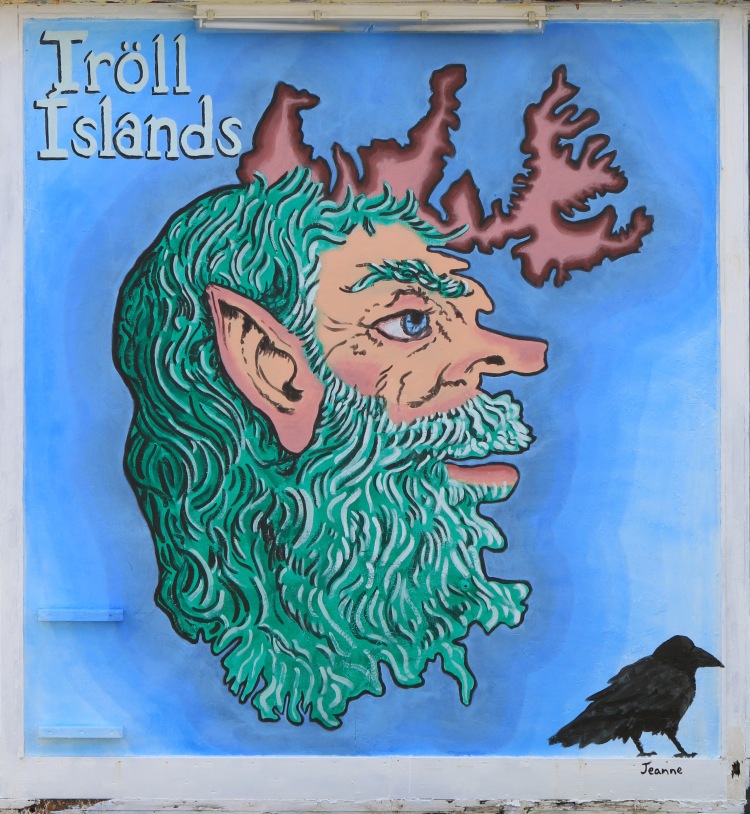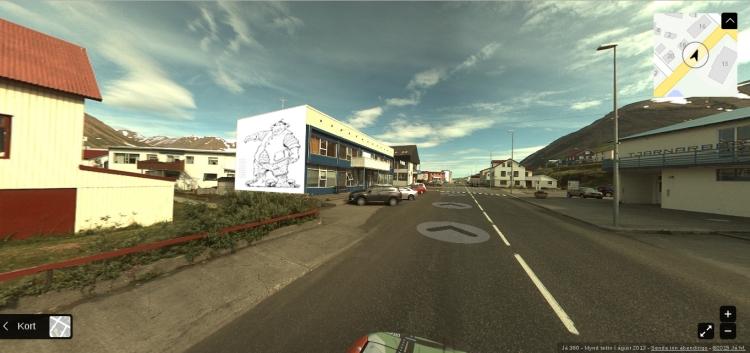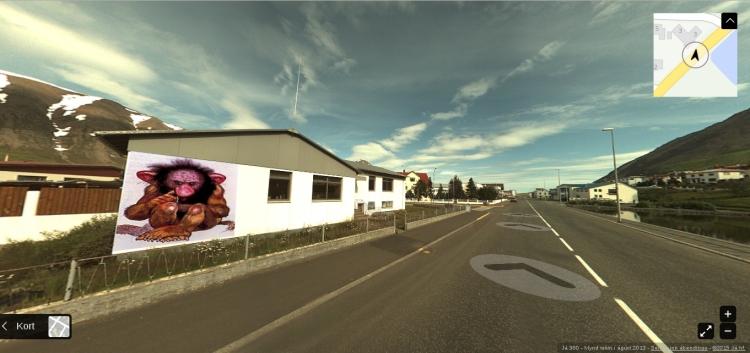i just finished writing a funding proposal for the trollagerdi project scheduled for the summer of 2017. so i thought i’d post it here, because the process was very good for deciding what i’m going to be doing. and of course, the moment i submitted it, i got revised pricing from someone in iceland, which alters the budget, and i also got wind of another artist who would be wonderful on the project, so that alters the lineup.
but that’s the way it goes. here’s the proposal.
Short description of the project:
Troll Garden: Bringing Trolls to Tröllaskagi is a collaborative multimedia public art project, developed with Listhús SES and local participants, to celebrate the region’s folklore and natural history, and honor the peoples’ innovation and independence. Fjallabyggð, North Iceland, June-August 2017
Project description:
Troll Garden: Bringing Trolls to the Troll Peninsula – Tröllagarður: Koma tröllum á Tröllaskaga
Our project calls international artists to a small fishing village in northern Iceland to install a tribe of trolls.
Soon, a giant stone troll marks the approach to the town, and small trolls hulk on the sides of the roads, while troll murals appear on houses, made by an international team of visual artists.
Local students submit original folklore research to the national archive. Artists and students film and edit a documentary about the summer’s activities – a garden-troll contest led by a local potter, tiny elf doors made by children, a knitting design contest run by the local gallery, a Danish-run cookbook workshop, a photo competition, a street art party, craft workshops, and more – open to all, intended to nurture bonds between artists and locals.
Our project features free monthly exhibitions, performances and talks, creative exhibitions for children and adults, and public workshops given by local and international artists, finishing with a festival of art, food and music. Our project relies on the input and participation of international educators as well as artists. Above all, local cooperation and engagement at all levels is vital to – and the measure of – its success. The precise scope of our project depends on the locals; we have their support and enthusiasm for the project, and plan to make the troll festival an annual event.
We will introduce trolls and fairies/hidden people into the fabric of daily life and observe how the townspeople react to their presence, as an exercise in community expression. We propose to engage the community in an abstract conversation about place – their physical place in a remote and breathtaking environment, as well as their cultural place in history and modern society. A dialog between trolls and townspeople playfully highlights issues the town faces in its growth – employment, social welfare, sustainability and quality of life.
Our project offers the community a metaphorical space where they can develop new waysof working together to solve local issues.
Tröllaskagi is the most mountainous region of Iceland. Sparsely populated, its fishing villages were isolated from each other until the 21st Century. When the new tunnels opened, the villages were incorporated as Fjallabyggð. With its fishing industry in decline, the area’s population is shrinking, and civic cohesion is important to their sustainability.
Ólafsfjörður is a town of 800 in Fjallabyggð. Its people are independent, self-sufficient, and family oriented; each person fills multiple roles in the town. Its remoteness has kept the world away – there is little tourism, but the area is rich in nature and sports, culture and art. The townspeople are open to artist initiatives, and very welcoming of strangers who come to stay and learn about them.
Listhús is an artist residency in Ólafsfjörður, with a mission to develop arts and culture as part of the area’s vital attractions. Up to 14 international artists a month gather to make art in the North. They come for the landscapes, the extremes, the isolation, the stunning scale, a quiet place to concentrate on their art practice. They come to experience the North, to explore the changing environment, to hike and fish and ski and surf, to meet the people and experience the culture.
Listhús promotes collaboration between artists and local people, and cultivates a base of local art expertise to benefit international artists. The area has many local artists, and our project draws on their cultural knowledge. They act as guides to the artists, and as mediators between artistic impulses and the town’s needs and preferences. Listhús is partnered with Menntaskólinn á Tröllaskaga, the local junior college, where there are teacher collaborations with the artists, and frequent classes and workshops.
Describe the project’s activities and time schedule (what, where, when?):
Our project runs from June-August 2017, three months of art and activities around Fjallabyggð. Artists spend 2-12 weeks at Listhús, with studios, workshop and gallery space, and town resources such as a woodshop, printshop, pottery studio, gift shop, classrooms, professional kitchens, event and exhibition space, and audio/video equipment. Artists work on established projects, noted below, or propose something of interest to themselves and the town.
Pre-project
Troll Research. Students record nursing home residents’ folklore memories and local tales. March-April 2017
Art Projects
Troll Woman on the Hill. 5m Volcanic stone figure, painted and landscaped, on a hill above the town. June-August
Little Trolls. Individual artists design and build small stone trolls by the roads. June-August
Troll Murals. Murals designed by the artists, varying in size and complexity. June-August
Community Workshops and Contests
Little Elf Door Paste-Up Party. Teacher and children design and decorate paper doors, and install them around town. June
Troll Food Cookbook Workshop. Professional and amateur cooks explore food chemistry, Nordic cooking, and local ingredients. Results featured at Troll Festival. June
Troll Photography Contest. Photo workshop, fieldwork, processing. Contest results during Troll Festival. July
Troll Sweater Design Contest. Friendly competition for the best troll-themed sweater. Contest results during Troll Festival. June-August
Garden Troll Workshop and Contest. Specially designed ceramic trolls decorated by all. Contest results during Troll Festival. August
Chalk Art Party. Families making public art together. July
Leather Workshop. Making bags from local materials. July
Meetings
Monthly Artist Meeting. Meet residents. June-August
Monthly Exhibit. End-of residency show. June-August
Troll Festival. Grand ceremony introducing projects, with contest results and awards, troll-food samples, live music. August
Describe how the project will contribute to development and innovation within its field of activities:
Our project focuses on four areas of activity: the Listhús art residency program; the artists; community enrichment; and cross fertilization. The development and innovation we seek also breaks down into four aspects.
Listhús art residency program – the project helps Listhús develop a program of artist-run projects influenced by the artists’ relationships in the community. This project is a further test and refinement of the idea. Through a series of such projects, Listhús seeks further growth and increased involvement in the region.
The artists – Listhús’ innovative residency structure and arctic themes attract experimental artists and groups who wish to explore the Nordic environment and stretch the bounds of their art practices through discussion and collaboration.
Community enrichment – In addition to beautifying the region with artwork, artists work in the community to solve problems creatively, and advance cohesion among the local people.
Cross fertilization – Encouraging dialog with international artists in an isolated town, and embedding artists with local cultural hosts, we see very personal art emerging as the artists become part of the town. We expect projects inspired by local issues to contribute to the development and enrichment of arts and culture throughout the region.
Describe how the project engages, or communicates with, its audiences, and how knowledge is disseminated between the actors participating in the project:
Audience communication:
Listhús has healthy local, regional, national and Internet publicity channels, and a network of alumni. Project artists use their own mailing lists to keep their audiences informed. Project leaders write articles for art, travel, nature and community publications. Local participation in the project should be robust because of the buzz created by student-led research, frequent community workshops, and contests.
Internal communication:
Working long-distance is essential to this project. Relationship is everything in Ólafsfjörður: it’s next to impossible to arrange things without face-to-face contact. The people I met on my first residency are competent, strong-willed and active locals who can ask questions for me, and suggest how I should shape my strategies and goals. They are the stakeholders, because it’s their town.
Currently, a dozen project partners use a closed Facebook group to post material and discuss ideas, issues and strategies. We communicate via instant messenger, Facebook, Skype, and emails. My project blog dates from 2013; the Listhús project page for the earlier phase of the project is also publicly available.
As new artists are added to the roster, they familiarize themselves with the project and help shape its direction. Our call to artists in October is skill-specific, and includes a detailed discussion of the project, an invitation for themed proposals, and a requirement for self-direction, communication, and commitment.
Short personal biography and country of residence for the central participants (artistic director, invited artists, etc.). [CV as attachment]:
All participants are central. Those listed below are provisionally confirmed.
Jeanne Morrison – Curator – US. Multimedia public art in a spirit of collective evolution. Writing, painting
Alice Liu – Director – Iceland. Video artist, animator, graphic designer. Managing Director, Listhús. 2016 Fjallabyggð Artist of the Year
Lára Stefansdóttir – Photography – Iceland. Principal, Menntaskólinn á Tröllaskaga (MTR). Instrumental in bringing computers into schools
Ida Semey – Cuisine and Culture – Iceland. MTR language teacher. Owns Kaffi Klara and Gistihús Jóa
Bergðór Morthens – Painting – Sweden. MTR art teacher using distant teaching. Widely exhibited in Nordic region
Lisa Thuler – Sculpture – Brazil. Founder, Principal, Academia Cristã Morada da Colina. Coordinator, grassroots education campaign for mastocytosis
Hólmfríður Arngrímsdóttir – Ceramic – Iceland. Owns Kaolin
Tómas Einarsson – Printing – Iceland. Owns Skiltagerð Norðurlands. ICE-SAR rescue leader
Shannon McRae – Folklore – US. Professor, program coordinator, SUNY. Herblore, photography
Katie Bush – Painting – US. Children’s education, High Museum Atlanta
Caitlin Bradley – Sociology – US. Cultural competence, social media. Poetry
Bego Anton – Multimedia – Spain. New documentarism photography
Margaret Dyer – Painting – US. Plein-air workshop teacher, Europe and US
Dallas Fox – Leathercraft – US. SCA medievalist, handicrafts
Will Huberdeau – Writing – US. Journalism, creative writing teacher
Co-operating partners (name, domicile and country of the project’s co-operating partners) Please specify which co-operating partners are confirmed and which are pending:
All of these are pending: many are Listhús alumni, others have expressed interest during online discussions. Confirmed partners are listed in 2.3
Invited artists
The following are invited to be part of the project, but have not committed:
Drawing – Cosima Scales – Sydney, Australia
Encaustic – Janice Steeves – Guelph, Canada
Film project – Ruan Suess – Scotland, UK
Film project – Samuel Cousin – Montreal, Canada
Folklore – Ragnhildur Jonsdottir – Hafnarfjörður, IS
Painting – Kari Henriksen – Melborne, Australia
Painting workshop – Lesley Hicks – Gateshead, UK
Multimedia – Claire Bushby – Perth, Australia
Multimedia – Gretchen Pankhurst – Scotland, UK
Mural painting – Alejandro Dorda (Axel Void) – Madrid/Miami
Mural painting – Joe Dreher – Atlanta, US
Sound – Kate Carr – Belfast, UK
Troll architecture (bus shelter) – Laurence Falconet – NYC, US
Call for artists
In October, we issue an international call to artists, seeking innovative artists in all media. Applicants propose a self-directed public art project, or plan to collaborate on larger projects, in addition to their own residency practice. We’re looking for artists who are multi-disciplined and enthusiastic, interested in engaging the community and exploring a country where folklore is part of an active tradition. We seek predominantly non-native English speakers to diversify our roster, and anticipate a significant number of Asian artists through Listhús connections.
The main focus of this project is on the sustainability and quality-of-life issues facing people in the North, and the possibility of addressing some of these problems using art. The project happens within the context of Fjallabyggð’s redevelopment cycle, and we hope to facilitate that process with a creative dialog between townspeople and artists.
Describe the Nordic and possible, European, and/or international dimensions of the project:
The Nordic region is well represented in this project by the people of Fjallabyggð, as well as some of the principal partners, one of whom comes from Denmark, another commuting from Sweden. The project relies heavily on our Nordic partners to set the tone and direction as cultural ambassadors.
The project is a collaborative effort between artists, directed by input from the local people. The nature of this project is cross-disciplinary and international, drawing on artists from all over the world who have an interest in Nordic lands and cultures in general, and Nordic folklore in particular. Educational professionals on the project team are drawn from Iceland, Brazil, Denmark, China, and the US. Resident artists come from all over for their own unique reasons, bringing cultural diversity with them, and returning home with a new emphasis on Nordic themes in their work.
How is the project planning to disseminate information about its activities and the results thereof (aim/objectives, strategies, working methods and expected impact of the activities)?
We aim to engage the local population, contribute to the evolution of art residency practices, and encourage artists to experience Iceland more deeply than tourists can.
We use all available methods of publicizing and involving the local people; use our contacts in regional media to generate interest; insert stories in national and international media, tourist publications and in-flight magazines.
Articles focus on art, travel, culture and folklore, featuring resident artists and their projects. Blog posts begin pre-project, increasing in frequency and detail with time. All artists post to social media during the project, which will live on in a “Making Of” film by residents and local college students.
We hope to see a more vibrant town with an increasing population and widespread renown for its nature, art and culture. The impact should increase slowly over time, encouraging cultural health and helping the town avoid the superficial and disruptive type of tourism.
What communication channels do you plan to use (e.g. social media, websites, events, advertising, publications or similar)?
Local – Because of our network, the local people know about our project 18 months beforehand. Best communication is low-tech – word of mouth, flyers, posted notices.
Social – Each artist agrees to fully document and publicize their part in the project. Some artists use blogs to showcase their experiences; others use a variety of social media, from Facebook and Instagram to YouTube, LinkedIn and Vimeo.
Media – We will feature our project on TV (N4), publications (Grapevine, Lögberg-Heimskringla), promotional articles in travel, tourist, and art magazines, demonstrations on Instructables, Inhabitat and Trendhunter, murals in Juxtapoz.
Advertising – Full page ads in local and regional papers and websites, international call to artists.
Events – Frequent events to capture the interest of the local people and encourage interaction with the artists: talks, meetings, performances, parties, workshops, a festival.
Extra – We are able to go live with our project via the city’s webcams.
Comments on the budget and the financing plan:
Assumptions:
In the budget, pricing for commercially-available materials was obtained online, through Icelandic office supply and hardware catalogs (A4 and Byko), and may therefore contain inaccuracies; thus a contingency percentage is crucial to cover changed prices and overlooked essentials.
As to the financing plan, we are assured of the free use of heavy equipment and their drivers, but cannot depend on their availability because they are essential to the running of the town, which has only 2 months to do a year’s work. This may result in a need for emergency funding to rent equipment and hire drivers; funding we will raise privately by subscription should it become necessary.


